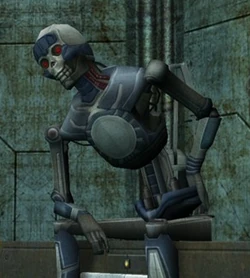
G-OLM's story of the Chinese Room.
The Chinese Room is a game mechanic found in Zero Escape: Virtue's Last Reward.
History[]
The Chinese Room was originally a thought experiment presented by John Searle.
A person who has no knowledge of Chinese is locked inside a room with a bunch of books with Chinese answers to Chinese questions. The person inside the room receives slips of paper on which questions have been written in Chinese. The person must appropriately answer the questions using the books found in the room. This thought experiment was originally presented in order to challenge the philosophical position of Strong AI, which is the idea that a computer programmed to simulate the human mind can actually be considered to have a mind and 'think' in the same way a human does.
Virtue's Last Reward[]
Luna END[]

G-OLM, the GAULEM who tells the story.
After Sigma, Alice and Luna meet G-OLM in the GAULEM Bay, he complains about his back hurting and his shoulders being stiff due to him being in maintenance. Sigma asks why G-OLM's shoulders get stiff even though he's a robot. G-OLM launches into a lengthy explanation about the Chinese Room. In his story, a young woman is trapped in a room into which Chinese people can insert questions. Since the questions are in Chinese, the woman doesn't understand them. When she was captured, she was told to respond to the questions appropriately. She can't respond on her own, so she must search around the room for help. She finds and uses a collection of Chinese phrasebooks. These books have Chinese answers to Chinese questions. However, they have no translations for the questions or answers. She uses the phrasebooks to match the characters on the paper to those in the book. She then writes the corresponding response and returns the paper. Since she just copies the symbols from the phrasebooks onto the slips of paper, she has no idea what the questions or answers say.
After concluding the story, G-OLM states that the Chinese people outside would think that the person inside the room spoke Chinese like them due to the appropriate responses he also states that that may be how humans can retain information. Sigma asks him what this has to do with G-OLM feeling pain. G-OLM responds that his shoulders being stiff--or any other pain for that matter--is the central computer's way of stopping him from doing whatever is causing the pain. Alice asks if the way robots feel pain is different from the way humans do. G-OLM vehemently disagrees and states that robots aren't much different from humans if you ignore the mainframe and signalling.
G-OLM states that humans, when asked a question, may merely pull out an answer from the phrasebook in their brain. He goes on to state that a robot is pretty much indistinguishable from a human if it looks like a human and acts like a human. In fact, you probably couldn't tell the difference between a robot and a human if the robot looks and acts convincing enough. He then explains Artificial Biological Tissue (ABT) and that all GAULEMs sport a coat of it when they are first created. ABT is made to look and feel just like real skin and hair including slight blemishes and imperfections. Since the GAULEMs in the GAULEM Bay have been in disrepair for several decades, the ABT has corroded and left behind the metal skeletons to which the ABT was applied. He was about to tell Sigma and Alice that Luna was also a GAULEM, but his body was deactivated by Zero III before he could finish.
Later, after Sigma and Phi find out that Luna is a G-OLM in the Director's Office, Phi theorizes that Luna could be the girl in the room and that the other players were the people outside of it. She also believes that the game may have been set up to also see Luna's true potential.
Trivia[]
- The woman pictured in G-OLM's Chinese room story looks very similar to Luna.
- In the story, the young woman is asked if she is hungry and when she responds that she hadn't eaten since breakfast, is served twice-cooked pork. Later on while searching the pantry, Phi tells Sigma about the several dishes which she had partaken in eating. A few minutes later, she recalls quite loudly that she also ate some twice-cooked pork. Sigma, finding this particularly peculiar, explains the Chinese Room story to Phi, including the detail of the twice-cooked pork mentioned in the story. The game never explains why Phi suddenly revealed that she had eaten twice-cooked pork in such an odd way.
- When Sigma and Phi find out that Luna is a GAULEM, Phi mentions the Voight-Kampff test from the book Do Androids Dream of Electric Sheep? by Phillip K. Dick. This implies that the Nonary Game could be like a Voight-Kampff test for Luna.
